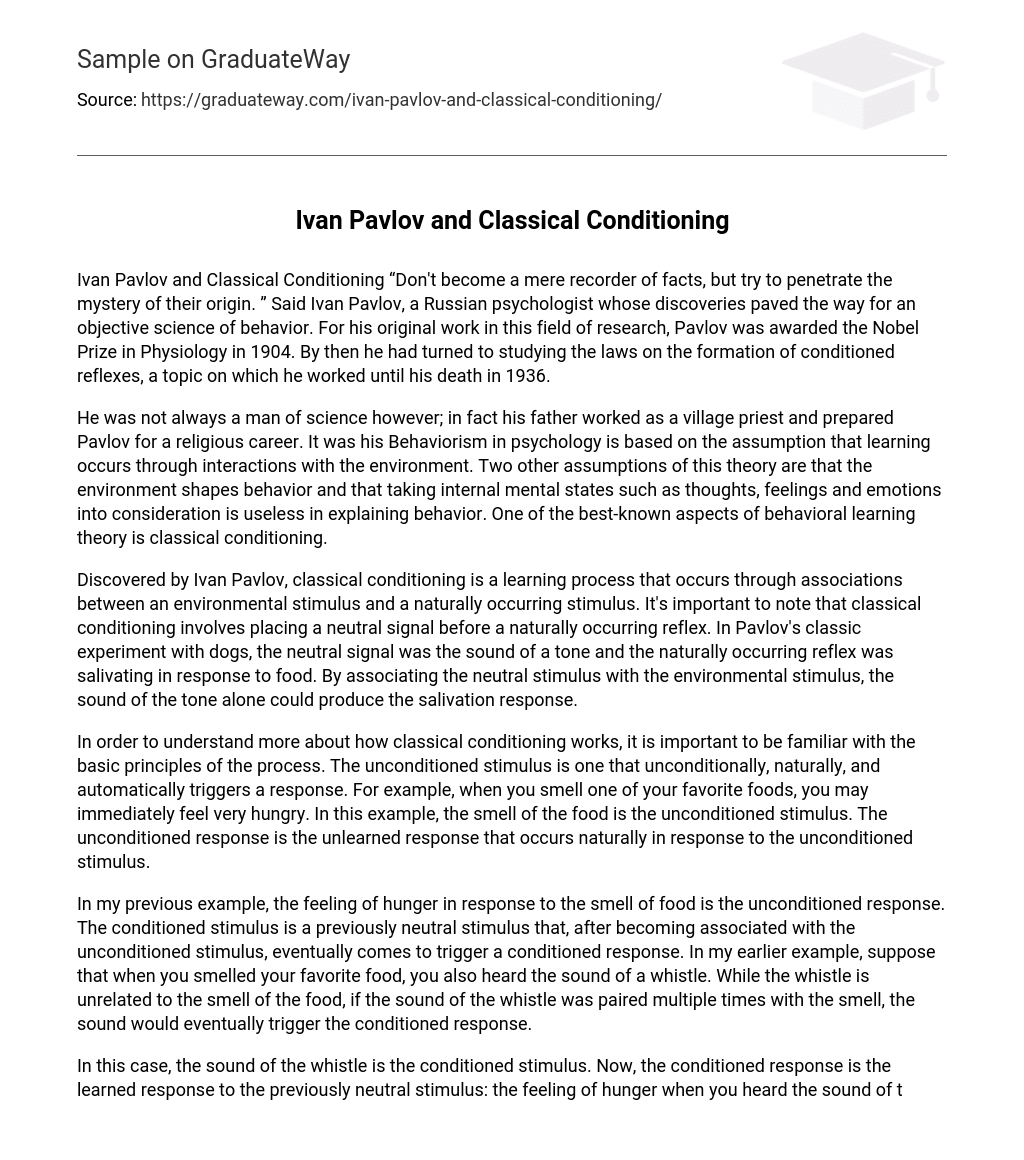Ivan Pavlov, a Russian psychologist, was honored with the Nobel Prize in Physiology in 1904 for his groundbreaking work in behavior research. He stressed the significance of comprehending the origins of facts rather than merely documenting them. In his career, Pavlov dedicated his efforts to investigating the principles associated with conditioned reflex formation until he passed away in 1936.
Despite his father’s initial preparation for a religious career, Pavlov did not always pursue this path. His behaviorism in psychology is based on the idea that learning occurs through interactions with the environment. According to this theory, behavior is influenced by the environment and trying to explain it through internal mental states like thoughts and emotions is pointless. Classical conditioning forms an important part of behavioral learning theory.
Ivan Pavlov discovered classical conditioning, a learning process that involves associating an environmental stimulus with a naturally occurring stimulus. This process requires presenting a neutral signal before the naturally occurring reflex. In Pavlov’s well-known dog experiment, the neutral signal was a tone and the natural reflex was salivation in response to food. By connecting the neutral stimulus with the environmental stimulus, only the sound of the tone could cause salivation.
Understanding classical conditioning requires a grasp of its basic principles. An unconditioned stimulus is an automatic trigger that induces a response. For example, the scent of a beloved dish can immediately elicit hunger. Here, the food aroma serves as the unconditioned stimulus. The unconditioned response refers to the innate reaction that naturally occurs in relation to this stimulus.
The previous example demonstrates the relationship between the smell of food and the unconditioned response. The conditioned stimulus initially has no significance but becomes associated with the unconditioned stimulus, resulting in a conditioned response. For instance, suppose we consider a hypothetical situation where the sound of a whistle is linked to the aroma of your preferred dish. Despite there being no inherent connection between the whistle sound and food odor, if they are consistently paired together, ultimately the sound of the whistle will elicit a conditioned response.
Classical conditioning is the use of a conditioned stimulus, like a whistle sound, to cause a conditioned response such as hunger. It is often confused with operant conditioning, which pertains to the voluntary or involuntary nature of behaviors.
Classical conditioning associates an automatic response with a stimulus, while operant conditioning links voluntary behavior to its consequences. In operant conditioning, rewards serve as motivation for the learner, whereas classical conditioning does not involve incentives. It is important to mention that classical conditioning is passive for the learner, while operant conditioning requires active participation and performing an action to receive either a reward or punishment.
Teachers, parents, psychologists, animal trainers, and individuals from various fields employ classical and operant conditioning techniques for different reasons. In a 1974 study conducted by Carl Gustavson, John Garcia, Walter Hankins, and Kenneth Rusiniak, taste aversion was used to classically condition coyotes to refrain from preying on sheep. The researchers achieved this by injecting domestic sheep meat with a nausea-inducing drug. As a result, the coyotes became sick after consuming the sheep meat and consequently learned to avoid approaching groups of sheep.
In a classroom setting, a teacher can use operant conditioning by giving tokens as rewards for good behavior. These tokens can be exchanged by students for treats or extra play time. Although people in reality are more complex than Pavlov’s dogs or Gustavson’s coyotes, the fundamental principle remains the same. By establishing a positive environment with rewards for desired behavior, teachers and employers have found classical conditioning techniques to be effective in reducing anxiety and stress.
Through the combination of anxiety-inducing situations and pleasant environments, individuals acquire the ability to remain relaxed and composed. Ultimately, Pavlov’s inquisitiveness and determination to comprehend the root causes of phenomena fueled his groundbreaking research, serving as the foundation for contemporary Psychology. Establishing a link between an involuntary reaction and a stimulus is vital for the learning process, and illustrations of classical conditioning are prevalent in today’s society.





